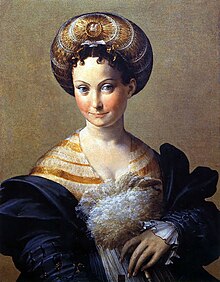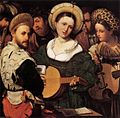Balzo headdress

The Balzo was a headdress worn by noblewomen of Italy in the 1530s. It was donut-shaped but appeared turban-like from the front, though it was generally worn further back from the forehead exposing the hair, unlike a period turban.
It is assumed as a fashion invention by Isabella d'Este, first documented in letters in 1509 and 1512[2] and well copied in later years.
The headdress was a throwback to a larger rounded headdress from the 15th century in Italy that covered the hair of the wearer.[3] Then the hairline was often plucked. Though mostly known as a woman's headdress, there is evidence that men also wore a form of the balzo.
-
 Profile Portrait of a Lady, c.1410 portrait of a woman wearing an "early balzo" with a plucked forehead
Profile Portrait of a Lady, c.1410 portrait of a woman wearing an "early balzo" with a plucked forehead -
 Francesco Francia attributed - likely Isabella d'Este in 1511
Francesco Francia attributed - likely Isabella d'Este in 1511 -
 Two women and a man wearing a balzo, showing the differences in style
Two women and a man wearing a balzo, showing the differences in style
References

Wikimedia Commons has media related to Balzo.
- v
- t
- e
Clothing
uniforms
and gowns
| Formal, semi- formal, informal | |
|---|---|
| Casual |
|
and lingerie
| Top | |
|---|---|
| Bottom | |
| Full |
and
outerwear
| |||||
| Other | |||||
|---|---|---|---|---|---|
| Western |
|---|
 Clothing portal
Clothing portal












